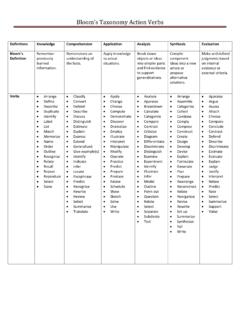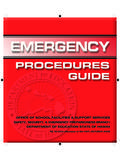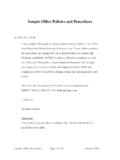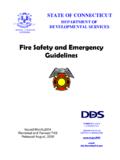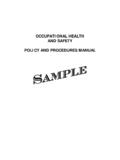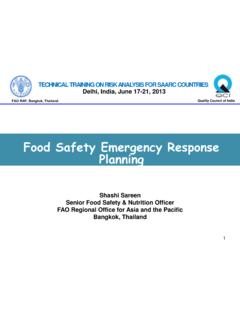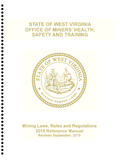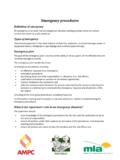Transcription of SAFETY OF LIFE AT SEA (46 CFR 199.180) …
1 Prepared by Deck Cadet John Neumann SAFETY OF LIFE AT SEA (46 CFR ) emergency equipment AND procedures training SHIP GOLDEN BEAR TSGB emergency equipment and procedures Contents Station Bill and Mustering Procedure 3 Hazards of Exposure 3 Life Jackets, Immersion Suits, and Anti-exposure Suits 4 Life Buoys 5 Radio Lifesaving Appliances 6 Pyrotechnics and Line Throwing Apparatus 8 Lifeboats 1-4 Launching and Operating procedures 9 Lifeboats 5-6 Launching and Operating procedures 13 Lifeboat Survival equipment Inventory 16 Liferafts 18 Lifeboat and Liferaft equipment 19 Rigid Hull Inflatable Boat Launching and Operation procedures 20 Illumination of Survival Craft Launching Areas 21 Self-Contained
2 Breathing Apparatus 22 emergency Escape Breathing Devices 23 Portable Fire Extinguishers 24 Methods of Retrieval 25 TSGB emergency equipment and procedures 3 Station Bill and Mustering Procedure All crewmembers and passengers are to report immediately to their emergency or boat station dressed and ready to perform the tasks specified by the ship s Station Bill. emergency muster will be taken by the station s Person in Charge or his/her designate, and will be brought to the ship s muster team stationed in the chart room aft of the bridge.
3 In the event of a fire, emergency , or abandon ship situation, personnel are to transit as much as possible via the ship s exterior to their specified station. Attention should be given to emergency signage is posted in various places around the vessel, designating muster areas, escape routes, medical facilities, and stair tower traffic directions. The vessel s station bill designates specific alarm signals, muster stations, and emergency duties to all personnel. All aboard are assigned billet numbers, which organize fire and emergency response, abandon ship procedures , and man overboard situations.
4 Upon arriving to the training Ship Golden Bear, all persons must familiarize themselves with the Station Bill and their assignments. Station Bills are located in the bridge, mess rooms, and outside the Chief Mate s Office. emergency Signals: 1. Fire and emergency : Continuous sounding of the general alarm bells and ship s whistle for a period of at least 10 seconds. 2. Abandon Ship: More than six short blasts and one prolonged blast on the whistle and same signal on the general alarm bells. 3. Man Overboard: Hail and pass the works Man Overboard to the bridge.
5 The bridge will sound three prolonged blasts on the whistle and general alarm bells. Signals for handling boats: 1. Lower Boats: One short blast on whistle. 2. Stop lowering Boats: Two short blasts on whistle. 3. Dismissal from stations: three short blasts on whistle. Hazards of Exposure One of the greatest concerns when abandoning ship is exposure to the environment, especially in cold water. Hypothermia is the decrease in a person s core temperature, and can occur within minutes of entering water or suffering from exposure to extreme cold.
6 Symptoms include violent shivering, muscle stiffness, difficulty breathing, loss of manual dexterity, mental confusion, and loss of consciousness. Death will follow severe hypothermia without treatment and warming of the victim. Hazardous environments are not always obvious. Water temperatures of 70 F can result in hypothermia as the body cannot generate heat as quickly as it is lost to the water. Hypothermia can set in when out of water as well, especially when wet and exposed to wind for extended periods. The best method in preparation for exposure to cold is the use of warm clothing.
7 This includes wool and synthetic materials, personal floatation devices, wet suits, dry suits, immersion suits, thermal protective aids, etc. It is also important to shed wet clothing such as cotton when in cold weather as it greatly increases the rate of heat loss to the environment. TSGB emergency equipment and procedures 4 Immersion Suits Immersion suits are designed to temporarily insulate the wearer from temperature hazards posed by the water in abandon ship situations. SOLAS 74-83 regulations require these suits to be designed so as to be donned in less than one minute and to offer the same level of buoyancy and visibility to the wearer as would a personal floatation device.
8 Additional items fitted to immersion suits include a buoyancy bladder with a one way fill tube and valve, a whistle on a lanyard, retroreflective tape, and a water activated light. The adult universal size fits body weights between 110 to 330lbs. Personal Floatation Devices Personal Floatation devices (PFDs) are issued to every person upon boarding, and are maintained in the crewman s or passenger s berthing while underway. Type 1 Off-Shore PFDs are designed to provide approximately 20-25 pounds of buoyant force to the wearer when submerged, and are fitted with retroreflective tape, a whistle on a lanyard, and a water activated light.
9 The vessel s name and PDF size is printed on the fabric, with child sizes worn by persons weighing less than 90 pounds. An additional 10 percent of the vessel s required carriage must be of Child size. PFDs may be worn beneath Thermal Protective Aids, and should be worn at all times after abandoning ship. Donning Instructions: 1. If provided time, remove shoes or cover with plastic bags for easier entry. 2. Don the suit as you would a pair of coveralls. 3. Pull hood over head. 4. Close zipper fully. 5. Adjust wrist and ankle bands.
10 6. Close face flap. 7. Once in water, depress mouthpiece and blow through air bladder tube to inflate for additional buoyancy. Donning Instructions: 1. Make certain body strap is on outside of preserver. Put arms into openings and tie neck tapes. 2. Pull lower tie tapes tight and tie securely. Attach body strap with snap and D-ring assembly and pull tight. 3. If necessary to jump overboard, hold PFD securely at upper front chest opening until in the water. TSGB emergency equipment and procedures 5 Thermal Protective Aid (TPA) Thermal protective aids are constructed from light weight, reflective material and designed to reduce the amount of body heat wearers loose to the environment.



